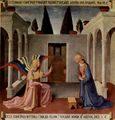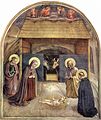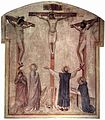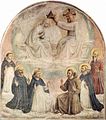Fra Angelico
Guido di Pietro, better known as Fra Angelico or Fra Angelico, O. P. (Vicchio, province of Florence, around 1395) - Rome, March 18, 1455), was an Italian 14th century painter who knew how to combine the life of a Dominican friar with that of an accomplished painter. He was beatified by John Paul II in 1982.
The artist was not known in life as Fra Angelico; this nickname was given to him posthumously, due to his religiosity.
Early Years
His secular name was Guido di Pietro da Mugello and he was born in Vicchio, Tuscany region. Although it is unknown who was his teacher, it is believed that he began his artistic career as an illuminator of missals and other religious books. He later began to paint altarpieces and tables. In 1417 he was already dedicated to painting sacred art. In 1420 he entered a Dominican convent outside Fiesole with his brother Benedetto. In 1423 he had already professed as a friar. He took the religious name of Giovanni di San Domenico (John of Saint Dominic).
Among the important works of his early days are the Madonna of the Star (c. 1428-1433, San Marco, Florence), the Fiesole Altarpiece (still conserved in said convent, although much modified by Lorenzo di Credi) and its predella, Christ in glory surrounded by saints and angels (National Gallery, London), in which more than 250 paintings appear. different figures. Two works entitled The Coronation of the Virgin (Saint Mark and the Louvre Museum, Paris) and The Universal Judgment (Saint Mark) also belong to that period. The maturity of his style is first appreciated in the Madonna dei Linaioli (1433, San Marco), where he paints a series of twelve angels playing musical instruments.
In 1436, the Dominicans from Fiesole moved into the convent of San Marco in Florence, which had just been rebuilt by Michelozzo. Fra Angelico, sometimes with assistants, painted numerous frescoes in the cloister, the chapter house, and the entrances to the twenty friars' cells in the upper corridors. The most impressive are The Crucifixion, Pilgrim Christ and The Transfiguration. The altarpiece that he made for San Marcos (c. 1439) is one of the first representations of what is known as "sacred conversation": the Virgin accompanied by angels and saints who seem to share a common space. There he painted an Annunciation.
Roman period
In 1445, Fra Angelico was taken to Rome by Pope Eugene IV to paint some frescoes in the Vatican's Chapel of the Sacrament, now defunct. In 1447, he painted the frescoes in the Orvieto Cathedral together with his disciple Benozzo Gozzoli.
His last major works, the frescoes in the Apostolic Palace to decorate the Nicolina Chapel, depict episodes from the lives of Saint Lawrence and Saint Stephen (1447-1449), and were probably painted by assistants from designs of the teacher. From 1449 to 1452, Fra Angelico was the prior of his convent in Fiesole.
His last commission was the fresco decoration of the cloister of the convent of Santa Maria sobre Minerva, which was the main Dominican convent in Rome. The iconographic program was designed by Juan de Torquemada, whom Fra Angelico had already known since his stay in Florence in the 1430s. These paintings have not been preserved. He died in that convent on February 18, 1455 and was buried. in a chapel of the basilica.
His work
Fra Angelico combined the decorative elegance of the Gothic, particularly the International Gothic of Gentile da Fabriano, with the more realistic style of other Renaissance masters, such as the painter Masaccio and the sculptors Ghiberti and Donatello, working in Florence, and he also applied the theories on perspective of León Battista Alberti.
The expressions of devotion on the faces are very successful, as is the use of color, which manages to give the work greater emotional intensity.
His mastery in the creation of monumental figures, in the representation of movement and in the ability to create planes of depth through linear perspective, especially in the frescoes made in Rome, confirm him as one of the most important painters of the first Renaissance.
Giorgio Vasari in his book Life of the Best Painters, Sculptors and Architects refers to him as Fra Giovanni Angelico, possessor of a “rare and perfect talent”, and mentions that "he never raised the brush without saying a prayer or painted the crucifix without tears rolling down his cheeks."
Works in Spain
In Spain there are three safe works by Fra Angelico and two others recently attributed. Two of his most representative works are preserved in the Prado Museum in Madrid, both from a fairly early phase of his production and, therefore, without the intervention of assistants. They place the Prado among the reference collections to know his art.
The first is the great altarpiece of The Annunciation (1422-1426), made for the Dominican convent of Fiesole, and present in the museum since its donation by the Spanish Crown in 1861. Said work It was given as a gift in Italy to the first Duke of Lerma, a trustee of King Felipe III, which explains its presence in Spain two centuries before the Italian primitives gained esteem in the international market.
The second work is the Virgin of Granada, acquired in January 2016 by the State from its then owner, the Duke of Alba, and which dates from 1426. The house of Alba had conserved said work in the palace of Liria since Carlos Miguel Fitz-James Stuart y Silva acquired it in Florence around 1817. The purchase price of La Virgen de la Granada amounted to 18 million euros, to be paid between the Spanish State (10 million), the Prado Museum (4) and the Friends of the Prado Museum Foundation (4).
This purchase operation also included the donation by the Duke of Alba of a predella that experts from the Madrid art gallery (and others from abroad, such as the Philadelphia Museum of Art) have also certified as a work from the brush by Fra Angelico himself, and in which a scene from the burial of San Antonio Abad is represented, with which the Prado Museum would have three works by the Italian artist.
For its part, the Thyssen-Bornemisza Museum in Madrid has the Virgen de la Humildad, painted in the artist's full maturity between 1433 and 1435, which belonged to the Thyssen family from 1935 until the purchase from the Thyssen collection by the Spanish State in 1993. It is currently on display at the MNAC in Barcelona, on loan from the Thyssen-Bornemisza Museum.
Finally, in the treasure room of Toledo Cathedral there is a Crucifix with figures of saints, a work rarely studied and known, but of great quality and that shows all the characteristics of the painter of Fiesole.
Gallery
Contenido relacionado
Garry Kasparov
Francis of Villagra
Daitoku Myō-ō


















